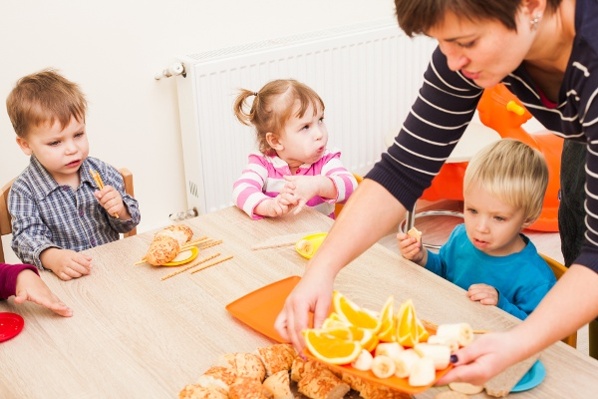Best Practices for a Healthy Child Care Facility
The things that children learn when they’re young provide stepping stones for the rest of their lives. This is why it is so important for children to learn and practice healthy behaviors in positive environments from the start. Childcare facilities are the perfect places to provide healthy foundations for children, and we have 3 easy practices to help you get started on making health and wellness a priority in your childcare facility.
Physical Activity
The National Association for Sport and Physical Education recommends that children 5 years of age and under receive 120 minutes of physical play every day. This number may seem daunting, but physical activity can be spread throughout the day in small bursts of 5-10 minutes, both inside and outside.
It is also important to provide a variety of activities throughout the day. Exercise for young children consists of active play sessions, as opposed to the exercise routines that we think of as adults. Walking, skipping, jumping, dancing and marching are all great forms of physical activity that also help children develop motor skills, build muscles, and foster creativity. Variety should also be apparent in the intensity of each activity. Children should experience both moderate activity, such as walking and dancing, and vigorous activity, such as running and jumping rope, every day.

Best Practices Checklist for Physical Activity:
- At least 120 minutes of active play per day
- Includes some structured activities led by adults
- Includes unstructured activities determined by kids
- Included at least 60 minutes of outdoor play, weather permitting
- Equipment is visible and accessible to children
- Teachers and volunteers are dressed for movement
- Teachers and volunteers actively participate and encourage movement
Healthy Eating
Family Style Meals
Eating family style meals and snacks is recognized as a best practice in child care settings. In family style dining, caregivers place enough food on the table to allow each child and adult to take a full portion. This way, children and supervising adults are able to share a meal together, and children are encouraged to serve food themselves. This practice helps children try new foods by allowing them to feel in control of their eating, and supervising adults can encourage healthy eating habits by role modeling them.

Tips for transitioning to family style dining in your childcare:
- Practice passing bowls of dry beans, dry rice, or pitchers of water with the children before implementing during meal service.
- Start small with easy to serve items, like buns or rolls, then expand to other foods one at a time.
- Keep towels or napkins nearby for quick cleanup or spills.
- Keep extra serving utensils on hand in case someone drops or inappropriately touches those in use.
Healthy Celebrations
Why healthier classroom celebrations?
“A birthday is just once a year,” we might think—but if you have 25 or more child birthdays, add in Halloween, winter break, Valentine’s Day…you can easily accumulate 7 full weeks of sugary treats! Providing physical activity as a reward instead of sugary treats promotes a positive relationship with exercise, and is just as fun!

5 ideas for healthy celebration activities
- Celebrate with extra time at recess or in the activity room.
- Turn on music and have a dance party.
- Lead a themed parade around the building.
- Go outdoors for an unexpected seasonal activity (e.g., sledding in winter, field day practice in spring, nature hike any time of year).
- Set up active game stations throughout the room and let students choose or rotate among them.
Learn more about how to make your childcare facility healthier:
Movement in Learning Resources, Kid-Friendly Veggies and Fruits, Alternatives to Food Rewards
Topics: Child Care, Healthy Eating, Physical Activity
Subscribe for more
Want more ideas for healthy schools, workplaces, child care providers, and families? Subscribe to our blog for weekly tips delivered right to your inbox!
Working Toward a Healthier District NEXT »
New opportunities for play on the far east side
